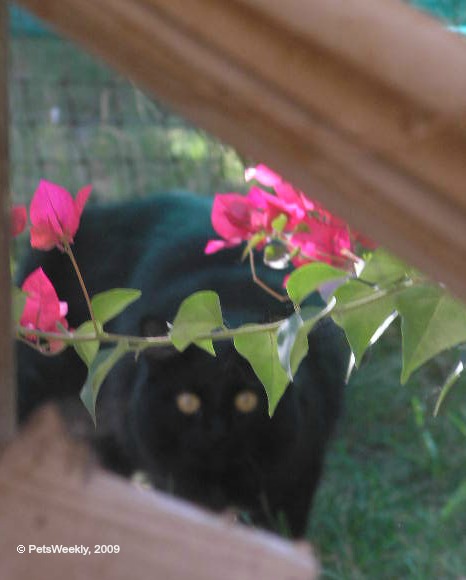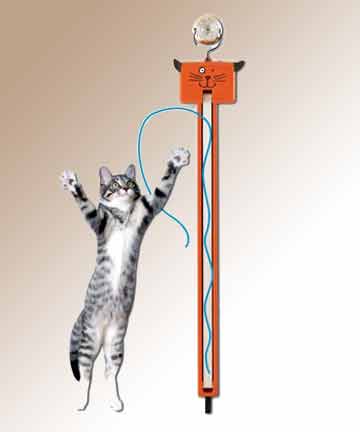Neighborhood Cat Pests
Share

 Booger,
Booger,
I’ve been dealing with many neighborhood cats (both domestic and feral) that are terrorizing my yard and home! We have tried things such as “repellents” but they don’t seem to work. How do you make your neighbors keep their pets indoors? And how do you stop them from coming into your yard? And most of all, how can we stop the number of cats in the neighborhood from escalating? We live near a park and I think they may be coming from there as well. My door is urine-soaked every morning and they even spray my windshield! The smell is terrible and I don’t even HAVE any cats!
Thanks,
Tom
Tom,
As we all know cats, both feral and domestic, can cause problems in a neighborhood. With a close proximity to the park, you are subject to many different types of animals, including cats that have just been abandoned and may not even be completely feral. So, while I agree that cats should be indoors, even if all the domestic cats are brought in, you will still have to contend with feral or abandoned cats.
Feral cats have a way of moving in and taking over a neighborhood, and that is the direct responsibility of no one. But, even that has a solution. Perhaps it is time to begin a Trap/Neuter/Release (TNR) program in the neighborhood? I’ve outlined the program below in a “solutions” area. As far as dealing with the neighbors who let their cats out, there are a number of ways to live harmoniously with both.
While I believe that the cat owners do their best, it is often difficult to bring a cat indoors that has previously spent its life outdoors. This is obviously difficult for people to relate too. If a cat has been indoors their entire lives, it is not difficult to keep them in. But, if cats are accustomed to having “free rein” and then are forced to be indoors only, it can be an impossible task to keep them confined.
As cats, and other domestic or feral animals, are protected by the law and intentionally injuring or killing one is a felony offense, all we can do is to try to live harmoniously and realize that there are probably more important issues in the neighborhood. But, cats can reek havoc and so let’s concentrate on the solutions, not the problems. Here is a down and dirty list on how each party can help solve the problem:
For the Owners
Fencing: While there are fences available that will keep cats in the yard, they are expensive (ranging between $400- $1000), and many of your good neighbors may simply be unable to afford them. These options include Purr…fect Fence and KittyWalk Cat Enclosures products. Both are excellent solutions, and if you are willing to work with your neighbors on incorporating these into their lives, you may just find that they are very willing to try them out. For more fencing options, check out this informative article on a Fencing Solutions.
Enclosures: Talk to the owners of cats about building a cat enclosure. These can be easily fashioned out of a large dog kennel and attached to the home with a small doggy door to give cats easy access outdoors or indoors. They could go all out and build an extensive enclosure, or there are also a number of pre-fabricated kennels that are very easy to erect and attach to the home via dog door. Cat enclosures are wonderful because they not only keep cats safe, they keep neighbors happy.
TNR Programs
Due to your proximity to a park, there are likely a number of pets who have been abandoned or lost. While these may be domesticated cats, they do not belong to anyone in particular. As all domestic animals are protected from injury or death by the law, one cannot harm them. In Arizona, it costs $90 to turn a stray into animal control, $70 to turn one into the AZ Humane Society, and you may never be certain if you are trapping a neighbors pet (which is against the law and could open you up for a lawsuit). If you were to turn a pet in to one of these organizations, and that pet were euthanized (which is often the case with cats), you could also become the subject of a cruelty investigation or legal liability. Therefore, trapping and RELOCATING should be avoided.Trapping, Neutering and Releasing (TNR) is when you work with a rescue group to trap neighborhood cats, take them in to be spayed and neutered, and then re-release them in the same area. It’s perfectly legal and highly effective. You can learn more about TNR at Alley Cat Allies.
Even if cats are trapped and removed to another area, it will not resolve the problem. Other cats will move into a colony to take the place of the missing one. Colonies are self-regulating. The only effective method of controlling your neighborhood cat population is with consistent Trap, Neuter and Release efforts. There are a number of organizations in the world who will assist you with this effort – if you need recommendations for your specific location, let me know and I’ll get my human to give you a list.
In the meantime, there are many ways to keep cats out of your yards. I hope that one or more of these work for you.
Doors being sprayed
- Aluminum Foil: Cats do not like the way that aluminum foil feels on their paws, or the sounds that it makes when stepped on. Placing a large piece of foil in front of, or taping against, the door is an inexpensive and simple way of stopping the problem.
- Scat Mats: There are several different types of scat mats. Some have raised points on them that do not injure the cats, but does deter them from entering the area and can be purchased for less than $12.00 at office supply stores. Another type of mat is the ScatMat Electronic Pet Training Mat
can be plugged into a nearby outlet and produces a static electricity charge that, when stepped on, will create a small static charge which keeps the cat away. These types of mats can be a bit more expensive varying between $50-$100.
- Motion-Activated Sprays: Innotek Multivet SSSCat Deterrent
is a motion-activated sensor that produces a safe spray and a loud noise when activated. They have a range of 3-10 feet, and this can be adjusted for height and range.
- Doublestick tape: Placing double stick tape on your doors, or most effective on doors. Sticky Paws
offers a wide selection of sizes and they will not harm your doors or windows. Cats do not like the feel of the tape, and will run away.
These are highly effective methods and quite inexpensive. Often these stop-gaps are only required for a short time period. The goal is to create doubt about a cat entering the yard.
Garden Areas
To keep cats out of your garden, you can try several things.
- Ornamental Pebbles/Gravel: cats do not like to walk on this, and they look nice in yards.
- Water: Keeping an area moist, which in our heat is a good idea anyway, will deter cats from entering the garden.
- Plants: There are several plants that work well for keeping pets out of your garden and/or yard. One of these is known as Coleus Canina, a newly developed plant that cats (and all types of animals) hate. It releases a stench that animals cannot handle. However, it only smells to the human nose when touched! It’s a pretty plant and works in nearly all types of landscaping and climates. You could also try using the herb, Rue. The blue leaves create a nice garden accent, and cats seem to hate the odor. Cats are not keen on the smell of citrus either, and so you could try using orange or lemon peel in your yard as a deterrent. Other things that have been successful are coffee grounds, blood meal, lavender oil, lemon grass oil, citronella oil, peppermint oil and eucalyptus oil.
Entire Yards
Note that these solutions generally only need to be activated at night, when strays are most active.
- Water Bottle: Fill a clear plastic bottle halfway with water. Replace lid and set in the middle of the lawn. If you have a large lawn area, place two or three out. The theory is that cats are frightened away by light that travels through the bottle of water, giving off little “flashes”. He’s away
- Blank or Scratched CD’s: these work the same way as a water bottle by reflecting light and causing doubt in the cat when he/she enters your yard.
- Motion Activated Sprinkler
: These are essentially sprinklers that are motion activated. When a cat or other pet walks in front of it, they set forth a 3-second burst of water. They run about $50-100.
- Electronic Pest & Animal Control Repeller with Motion Sensor: These systems operate on a 9-volt battery and when a cat comes into range, it sets off an ultrasonic sound, undetectable to humans. Often they run about $60.
Hope these suggestions help a little with your cat issues! Remember that it is always best to start out with a little, then move into the power tools. It will be much more effective in the long run!!











